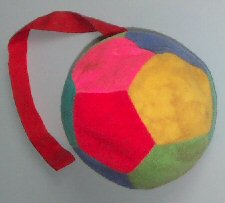 Dodecahedron
Dodecahedron


 Dodecahedron
Dodecahedron

Solid shapes --- cube --- tetrahedron --- octahedron --- icosahedron --- dodecahedron --- other shapes --- Euler's formula --- glossary --- for teachers
A dodecahedron's faces are pentagons (5 sides). There are 12 faces, and 3 faces meeting at each vertex (corner).

|
Model of a dodecahedronUnfortunately, my magnetic kit didn't have enough connectors to make a dodecahedron, so here is a child's ball instead. I think it needs washing! There is also a see-through picture of a dodecahedron for counting vertices (corners) and edges. See Euler's formula for what to do with these numbers. |

|

|
Net of a dodecahedronThere are 43380 distinct nets for the dodecahedron. Here is one of them. Print it out, stick it on thin card, score along the lines and fold them, form the shape, then stick it together with small amounts of glue. For more details, see the notes for the net of a cube. I'm afraid that the tabs are not very neat on this diagram as they were free-drawn by mouse, which I find tricky. Still, it doesn't matter as they end up inside your finished shape. |

|
Dodecahedral crystalsDodecahedra happen in crystals as well as cubes and octahedra. This is another natural pyrite crystal. It is not actually a regular dodecahedron, although it has 12 faces, each with 5 sides, but it is quite close. |
Roman dodecahedronObjects like this have been found on Roman sites in Britain, France and Germany. No-one knows what they are used for! |

|

|
Moving dodecahedronClick on Move or Backwards to make cube move and Stop to stop it.
|
A dodecahedron is the only regular polygon which uses pentagons, as it is impossible to fit more than 3 pentagons round a vertex. There are no polyhedrons which use only hexagons, as three hexagons at a vertex would make a flat surface. However, a buckyball uses both hexagons and pentagons.
© Jo Edkins 2007 - Return to Solids index